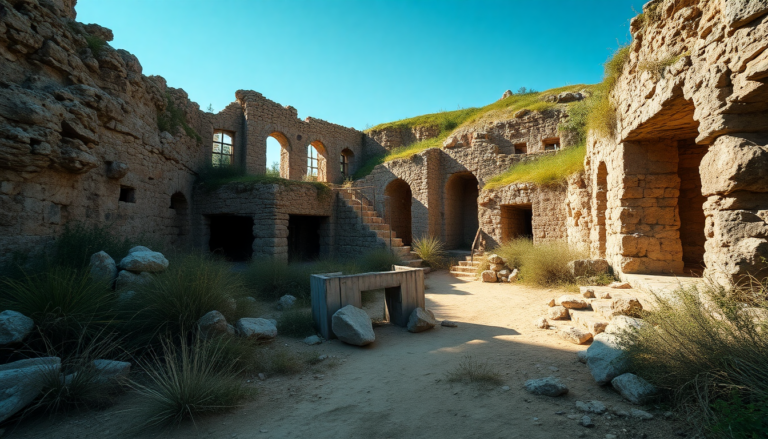Argomenti trattati
In the heart of Sardinia, a land steeped in history and vibrant landscapes, lies a journey that transcends mere travel. It’s an exploration of forgotten places, where every stone and shadow tells a tale of its past. Imagine wandering through abandoned mines, where the echoes of those who once toiled resonate in the air, weaving a tapestry of personal and collective memories. This is not just a trip; it’s a dive into a rich cultural narrative that connects generations.
Unveiling the mining heritage
As the sun sets over Sardinia, the charm of its mining towns becomes even more pronounced. These once-thriving hubs, now silent, invoke a sense of nostalgia. The film “La Guerra di Cesare” encapsulates this essence brilliantly, portraying the struggles of ex-miners navigating life’s harsh realities. The setting—specifically in Sulcis, where the town of Carbonia was founded during the Fascist era—brings to light the stories that deserve to be told beyond the island’s shores.
It’s fascinating to think about how these landscapes have transformed over time. The mines of Buggerru and Porto Flavia were not just sources of livelihood; they were the heartbeat of communities. Each location within Sardinia holds a piece of history, a glimpse into the lives of those who contributed to the island’s identity. Personally, I remember when I first visited these sites; it felt like stepping back into a time capsule, where the past and present intertwined seamlessly.
Personal connections and reflections
When Sergio Scavio, the director of the film, speaks about the importance of setting, one can sense the profound connection he feels to these places. He meticulously chose locations that resonate with his own experiences, evoking the fabric of his childhood memories. This approach not only adds authenticity but invites the audience to reflect on their own connections to the landscapes they traverse. It’s a reminder of how places can shape our stories, influencing who we are and where we come from.
Filming in Sardinia was not just about capturing visuals; it was an emotional endeavor. The residents, many of whom were involved in the film, brought their own narratives to the screen. This blending of local talent with the cinematic experience fostered a unique atmosphere of camaraderie. I will never forget the warmth of the locals, their eyes lighting up as they shared stories of the past—each tale a thread in the rich tapestry of Sardinian culture.
The essence of storytelling
What strikes me as particularly poignant is how “La Guerra di Cesare” delves into themes of failure and redemption, mirroring the decline of the mining industry in Sardinia. The journey of Cesare and Mauro reflects a broader narrative of lost opportunities and the quest for meaning in a rapidly changing world. It prompts a question that lingers: How do we find purpose in the ruins of what once was?
As viewers, we are invited to witness the transformation of these characters, paralleling the transformation of their environment. The interplay of history and personal journeys creates a compelling narrative that resonates on multiple levels. It’s a reminder that while the landscapes may change, the stories they harbor remain timeless.
Emotional landscapes
Setting a film in such evocative locations has its challenges and rewards. The rough beauty of Sardinia’s coastlines and the starkness of its mining sites serve as a backdrop that enhances the emotional weight of the story. Scavio’s deliberate choice to feature desolate, yet beautiful settings draws attention to the characters’ struggles, making their journey all the more impactful. It’s not just a visual feast; it’s a visceral experience that lingers long after the credits roll.
In one scene, as the sun dips below the horizon, you can almost feel the collective breath of the land, the sigh of its forgotten stories yearning to be told. It’s a moment of reflection, both for the characters and the audience—a reminder of the interconnectedness of our experiences.
The future of Sardinian cinema
As the film makes its way to broader audiences, it holds the potential to spark discussions about the future of Sardinia and its cultural identity. Will these narratives of struggle and resilience resonate with those outside the island? Personally, I believe they will. The themes explored in “La Guerra di Cesare” are universal, touching on the human condition in ways that transcend geographic boundaries.
Moreover, the collaboration with the Sardinia Film Commission has proven invaluable, fostering a supportive environment for local filmmakers. This relationship not only promotes the island’s cinematic landscape but also nurtures a sense of pride among the residents. I recall the palpable excitement in the air during the film’s premiere—a celebration of local talent and heritage that felt like a long-overdue acknowledgment of Sardinia’s rich storytelling tradition.
Final thoughts
Ultimately, this journey through Sardinia is not just a physical exploration; it’s a journey through the heart and soul of a place. Every corner of this island holds a story, a memory waiting to be unearthed. As you wander through its landscapes, consider the lives that have shaped them. The beauty of Sardinia lies not only in its vistas but in the narratives that entwine with its history, reminding us of the enduring power of storytelling.

